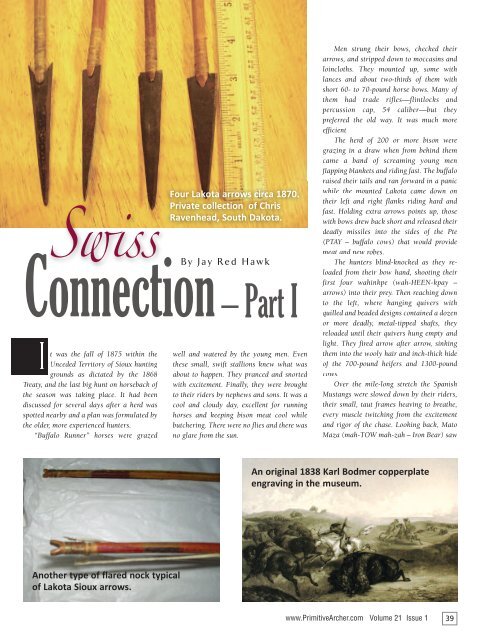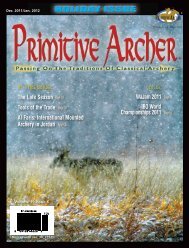In This Issue: plus: - Primitive Archer Online
In This Issue: plus: - Primitive Archer Online
In This Issue: plus: - Primitive Archer Online
You also want an ePaper? Increase the reach of your titles
YUMPU automatically turns print PDFs into web optimized ePapers that Google loves.
Four Lakota arrows circa 1870.<br />
Private collection of Chris<br />
Ravenhead, South Dakota.<br />
Swiss<br />
Connection<br />
B y J a y R e d H a w k<br />
The<br />
– Part I<br />
It was the fall of 1875 within the<br />
Unceded Territory of Sioux hunting<br />
grounds as dictated by the 1868<br />
Treaty, and the last big hunt on horseback of<br />
the season was taking place. It had been<br />
discussed for several days after a herd was<br />
spotted nearby and a plan was formulated by<br />
the older, more experienced hunters.<br />
“Buffalo Runner” horses were grazed<br />
Another type of flared nock typical<br />
of Lakota Sioux arrows.<br />
well and watered by the young men. Even<br />
these small, swift stallions knew what was<br />
about to happen. They pranced and snorted<br />
with excitement. Finally, they were brought<br />
to their riders by nephews and sons. It was a<br />
cool and cloudy day, excellent for running<br />
horses and keeping bison meat cool while<br />
butchering. There were no flies and there was<br />
no glare from the sun.<br />
Men strung their bows, checked their<br />
arrows, and stripped down to moccasins and<br />
loincloths. They mounted up, some with<br />
lances and about two-thirds of them with<br />
short 60- to 70-pound horse bows. Many of<br />
them had trade rifles—flintlocks and<br />
percussion cap, 54 caliber—but they<br />
preferred the old way. It was much more<br />
efficient.<br />
The herd of 200 or more bison were<br />
grazing in a draw when from behind them<br />
came a band of screaming young men<br />
flapping blankets and riding fast. The buffalo<br />
raised their tails and ran forward in a panic<br />
while the mounted Lakota came down on<br />
their left and right flanks riding hard and<br />
fast. Holding extra arrows points up, those<br />
with bows drew back short and released their<br />
deadly missiles into the sides of the Pte<br />
(PTAY – buffalo cows) that would provide<br />
meat and new robes.<br />
The hunters blind-knocked as they reloaded<br />
from their bow hand, shooting their<br />
first four wahinkpe (wah-HEEN-kpay –<br />
arrows) into their prey. Then reaching down<br />
to the left, where hanging quivers with<br />
quilled and beaded designs contained a dozen<br />
or more deadly, metal-tipped shafts, they<br />
reloaded until their quivers hung empty and<br />
light. They fired arrow after arrow, sinking<br />
them into the wooly hair and inch-thick hide<br />
of the 700-pound heifers and 1300-pound<br />
cows.<br />
Over the mile-long stretch the Spanish<br />
Mustangs were slowed down by their riders,<br />
their small, taut frames heaving to breathe,<br />
every muscle twitching from the excitement<br />
and rigor of the chase. Looking back, Mato<br />
Maza (mah-TOW mah-zah – Iron Bear) saw<br />
An original 1838 Karl Bodmer copperplate<br />
engraving in the museum.<br />
www.<strong>Primitive</strong><strong>Archer</strong>.com Volume 21 <strong>Issue</strong> 1 39



